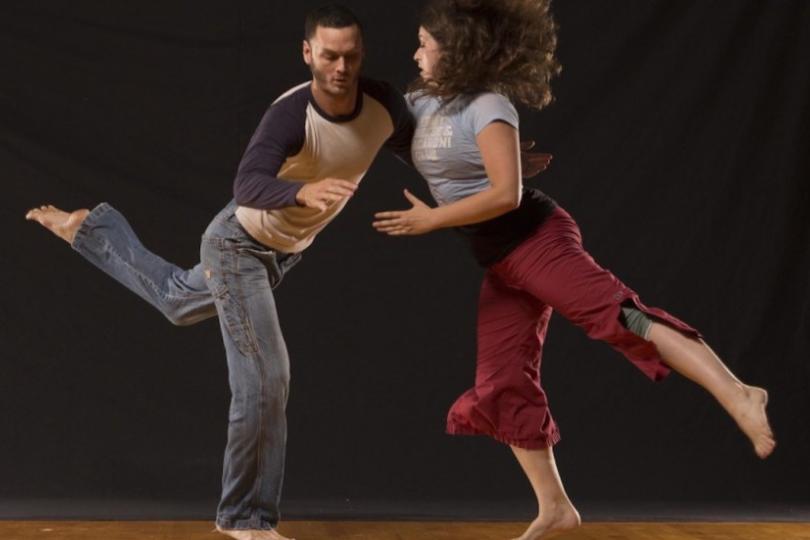The dance family

9x22 offers a monthly embrace of the Twin Cities dance family: instructors, performers, professors, and partners have been gathering for almost 12 years to explore and process experimental dance/movement pieces here. Lovingly curated and produced by Laurie Van Wieren, she explained: “[This started] because there was such a need for this kind of work..and there still is.”
Bustling by 8:00 PM on the fourth Wednesday of each month, Bryant Lake Bowl erupts with the happy ruckus of friends reuniting, collaborators reminiscing, and everyone ordering a lot of wine. Van Wieren greets the audience at the door, catching up with familiar faces and guiding others to seats for the show.
Last Wednesday, Timmy Wagner took the stage first, embracing the deeply experimental energy of this event. His piece, “Comfort Control,” explored his relationship with a male mannequin torso and the dance belt. A voiceover informed us about the use and benefits of this piece of fabric that will inevitably “get stuck so far up your ass anyways, you might as well pull it up there yourself.” On the bright side, “dancers like the security of knowing their testicles…[are not] bouncing and clanging” and distracting their audience, but instead are being shaped into the “meritable male bulge.” All the while, Wagner grappled with his mannequin counterpart (both in dance belts of their own), balancing it on his back, his arms, and his neck before gently setting it down on the stage.
After lights out, Van Wieren invited a now-clothed Wagner to discuss his work with the audience. Wagner shared the impetus for his piece: he found the mannequin by his house one night, “took him in, dressed him up” and “thought he looked good in a dance belt.” A genuinely surprised Van Wieren shared that “I’ve seen a lot of dance belts--but have never known a lot of those things!” [referring to the graphic detail with which the piece addressed male genitalia in relation to the dance belt], to much laughter. (For more info, Wagner recommends Doctor Dancebelt.)
Questions from the audience ranged from serious to silly--intertwining advice on working with objects with general impressions of the how well the music integrated to exploring gender constructs and the “idealized male form.” Wagner described the mannequin as “volatile,” referencing how his piece tests duration and balance because “if [the mannequin’s] not on right, it has a mind of its own.” The audience also asked about the image of carrying, the dance belt’s “streamlining” of gender, and the mannequin’s absurd six-pack.
Moving from mannequins to Tai Chi
Kathie Goodale and James Davies performed “The Bird” next. Deeply inspired from tai chi, the two paired deep breathing with gentle movement, intertwining strength and grace.. This time, Van Wieren asked about Goodale’s relationship with dance and music selection. Goodale shared how her interest in meditation, combined with her dance background, has helped her find “good support and love and good feelings.”
The audience’s emotional responses also revealed a sense of love and support. Goodale’s daughter congratulated her with a simple, “You look beautiful up there”; another audience member described the piece as both humble and intimate, a welcome combination.
In between pieces, Van Wieren invited other audience members in the dance community to advertise workshops and performances. She called everyone by name, bringing together a family spanning many backgrounds and experiences with dance.
Belonging
Since I felt like one of the few folks identifying as neither as a dancer nor an avid dance audience member, I tried to soak up the environment as an observer. Some comments definitely went over my head (what is “simulacra,” help?), but I was struck by the care and thoughtfulness demonstrated by the audience in actively processing the work. While definitely not yet a part of the family, getting a seat at the table was an unexpected gift. Added bonus: Meeting Judith Howard, Chair of the Carleton Theater and Dance Department and former Chair of the Dance Program at Macalester.
The final piece of the night belonged to Magnolia Yang Sao Yia, a Dance BFA candidate from the University of Minnesota. Of her work, the program note stated: “The marginalized experience as a woman of color shaping her social and political perspective, the continuum of patriarchy within her cultural context facilitating the violence and injustice taking place through her past and present history, are important subjects in which she chooses to address.”
In an acrobatic piece both beautiful and terrifying, performer Yang Sao Yia, who also performs with Ananya Dance Theater, explored power and histories of oppression. After her performance, Yang Sao Yia described the necessity of exploring Audre Lorde’s words through dance, particularly of wrestling with internalized oppression. She characterized this process as “resist, respond, [then] overcome” before laughing and admitting: “It’s a process.”
Audience members shared what they saw in her piece: “stories of trauma and resilience,” one said, “calmness and fierceness” offered another. Yang Sao Yia divulged everything from her personal history with the Hmong patriarchy to her choice of socks, her academic coursework in Asian American Studies to her mixed dance styles (“[I used the] pointed foot because look at these daggers! They look so good,” she exclaimed, showing her feet to a laughing audience).
Since 9x22 changes every month, the ongoing dance series captures “new, emerging, and established dance makers” alike—and I would definitely consider going back. The open environment to ask questions and share experiences blurs the line between dance extraordinaire and dance illiterate. It felt as though sharing impressions and reactions were always welcome and rarely wrong. Some artists wanted to continue their explorations, welcoming the feedback; others felt finished and were hungry for the next piece. Either way, the gift of engaging so intimately and supportively with other artists is sure to brighten your Wednesday evening.
On July 22nd, 9x22 presents the work of Bob Eisen, Katie Kaufman, and Missa Kes & Non Edwards.




